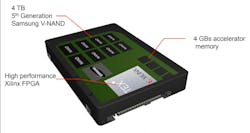FPGAs Emerge Everywhere
I remember when FPGAs were specialized devices requiring custom programming that could only be generated by wizards. They were often hidden inside radar systems or other high-performance platforms where the cost of the devices and programming was warranted. These days, that’s all changed.
Low-cost, flash-based FPGAs are in all sorts of embedded devices, and high-performance FPGAs are turning network interface cards (NICs) and solid-state drives (SSDs) into programmable computing platforms. It was once the realm of ASICs, where high volume made these practical for applications like encrypted disk drives. This assumes standard software interfaces with sufficient adoption to make the solutions practical.
Nowadays, FPGAs are mainstream. FPGA boards are found in the cloud alongside GPGPU boards and machine-learning/artificial-intelligence (ML/AI) accelerators. FPGAs can provide such support, but custom chips are often better for optimized ML/AI support. FPGAs offer a more flexible approach, allowing more than just ML/AI acceleration to be incorporated into hardware. Standardizing the APIs and driver interfaces has changed the way people view FPGAs, GPGPUs, and ML/AI support in the cloud.
The same is happening at the peripheral level. SmartNICs with bundled FPGAs accelerate and offload network processing chores from the host. This helps minimize system bandwidth requirements as well. It can also help keep data moving at wire speeds, where a host might otherwise become overwhelmed.
Xilinx’s SmartSSD computational storage device (CSD) is an example of how FPGAs are playing a role in storage (see figure). It’s not the first FPGA/SSD device on the market, but the push for use with standards such as the PCI Express-based (PCIe) NVMe make it a very interesting platform.
Like SmartNICs, SmartSSDs can utilize the FPGA to implement a variety of features that might otherwise need to be handled by a host processor. For example, a SmartSSD may be programmed to handle data compression and encryption. It could also turn the basic SSD into a content-addressable memory or even an ML/AI engine. Applications like real-time multimedia transcoding fit in both SmartNIC and SmartSSD arenas.
Moving computational chores closer to the peripherals makes sense, especially as data centers become disaggregated. It also makes sense in embedded applications, where functionality can be distributed to facilitate development and broaden modularity.
Keep an eye out for other peripherals, from cameras to motor control, to come with much more intelligence than in the past.
About the Author
William G. Wong
Senior Content Director - Electronic Design and Microwaves & RF
I am Editor of Electronic Design focusing on embedded, software, and systems. As Senior Content Director, I also manage Microwaves & RF and I work with a great team of editors to provide engineers, programmers, developers and technical managers with interesting and useful articles and videos on a regular basis. Check out our free newsletters to see the latest content.
You can send press releases for new products for possible coverage on the website. I am also interested in receiving contributed articles for publishing on our website. Use our template and send to me along with a signed release form.
Check out my blog, AltEmbedded on Electronic Design, as well as his latest articles on this site that are listed below.
You can visit my social media via these links:
- AltEmbedded on Electronic Design
- Bill Wong on Facebook
- @AltEmbedded on Twitter
- Bill Wong on LinkedIn
I earned a Bachelor of Electrical Engineering at the Georgia Institute of Technology and a Masters in Computer Science from Rutgers University. I still do a bit of programming using everything from C and C++ to Rust and Ada/SPARK. I do a bit of PHP programming for Drupal websites. I have posted a few Drupal modules.
I still get a hand on software and electronic hardware. Some of this can be found on our Kit Close-Up video series. You can also see me on many of our TechXchange Talk videos. I am interested in a range of projects from robotics to artificial intelligence.


